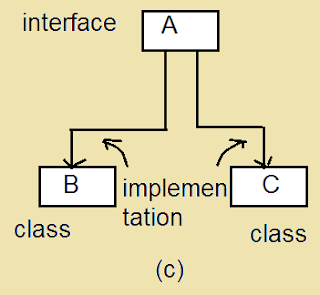Write about Interfaces in Java
Interfaces: Java doesn’t support multiple inheritance . classes in java can’t have more than one superclass. Java provi...
https://www.computersprofessor.com/2017/04/write-about-interfaces-in-java.html
Interfaces:
|
|
Java doesn’t
support multiple inheritance . classes in java can’t have more than one superclass.
Java provides an alternate approach known as interfaces, to support the
concept of multiple inheritance. Although a java class cannot be a subclass
of more than 1 superclass but it can implement more than 1 interface.
Defining interfaces:
An interface
is basically a kind of class like classes, interfaces contain methods and
variables but with a major difference. The difference is that interfaces
define only abstract methods and final fields. This means that interfaces do
not specify any code to implement. These methods and data fields contain only
contents. Therefore it is the responsibility of the class that implements in
interface to define the code for implementation of these methods.
The syntax for
defining an interface is very simple to that for defining a class. The general
form of an interface definitions.
interface
interfaceName
{
Variables
declaration;
Method
declaration;
}
Here,
interface is the keyword and interface name is any valid java variable (just
like class names). Variables are declared as follows.
Example:
interface Item
{
static final
int code=1001;
static final
string name=”fan”;
void display(
);
}
Note that the
code for the method is not included in the interface and the method
declaration simple ends with a semicolon.
The class that
implements the interface must define the code for that method.
Extending
interfaces:
Like classes,
interfaces can also be extended that is, an interface can be subinterfaced
from other interfaces . the new sub interface will inherit all the members of
the super interface in the manner similar to subclasses. This is achieved
using the keyword extends as shown below.
For example,
we can put all the constants is one interface and the methods in the other.
This will enable to use the constants in classes where the methods are not
receipted.
Interface item
extends
{
Int code=1001;
String
name=”fan”;
}
Interface item
extends item Constants
{
Void display(
);
}
The interface
item would inherit both the constants code and name into it. Note that the
variables name and code are declared like simple variables. It is allowed
because all the variables in an interface are created as contents although
the keywords final and static are not present.
While
interfaces are allowed to extend to other interfaces sub interfaces cannot
define the methods declared in the sub interfaces. After all, sub interfaces
are still interfaces, not classes.
Note that when
an interface extends two or more interfaces, they are separated by commas.
Implementary interfaces:
Interfaces are
used as “superclass” whose properties are inherited by classes. It is
therefore necessary to create a class that inherits the given interfaces.
This is done as follows.
Class
classname implements interfacename
{
Body of className
}
Here the class
classname “implements” the interface interfacename./.a more general form of
implementation may look like this.
Class
classname extends superclass
Implements
interface1, interface 2….
{
Body of className
}
This shows
that a class can extends another class while implementing interfaces.
Note that if a
class that implements an interface does not implement all the methods of the
interface, then the class becomes an abstract class and cannot be instantiated.
Accessing interface variables:
Interfaces can
be used to declare a set of constants that can be used in different classes.
The constant values will be available to any class that implements the
interface. The values can be used in any method as part of any variable
declaration or anywhere we can use a final value.
Example:
Interface Area
{
Final static
float pi=3.14 F;
Float compute
(float x, float y);
}
Class
rectangle implements Area
{
Public float
compute (float x, float y)
{
Return(x*y);
}
}
Class circle
implements Area
{
Public float
compute (float x, float y)
{
Return(pi*x*x);
}
}
Class
interfaceTest
{
Public static
void main(string args[ ] )
{
Rectangle
rect=new rectangle( );
Circle cir=new
circle( );
Area area;
Area=rect;
System.out.println(“area
of rectangle=”+area.compute(10, 20));
Area=cir;
System.out.println(“area
of circle=”+area.compute(10, 20));
}
}
Various forms of implementing interfaces:
Example for implementing multiple
inheritance:
Class student
{
int
rollNumber;
void
getnumber(int n)
{
rollnumber=n;
}
Void
putNumber( )
{
System.out.println(“roll
no is”+roll number);
}
}
Class test extends
student
{
Float part1,
part2;
Void
getmarks(flaot m1, float m2)
{
Part1=m1;
Part2=m2;
}
Void putmarks(
)
{
System.out.println(“marks
obtained”);
System.out,println(“part1=”+part1);
System.out.println(“part2=”+part2);
}
}
Interface
sports
{
Flaot sportwt=6.0F;
Void putwt( );
}
Class results
extends test implements sports
{
Float total;
Public void
putwt( )
{
System.out,.println(“sports
wt=”+sportwt);
}
Void display(
)
{
total=part1+part2+sports;
putNumber( );
putMarks( );
putwt ( );
System.out.println(“total
score=”+total);
}
}
class Hybrid
{
public static
void main(String args[ ] )
{
Results
student1=new Results( );
student1. getNumber(1234);
student1.getMarks(27.5F,
33.0 F)
student1.display(
);
}
}
|





